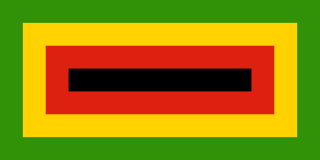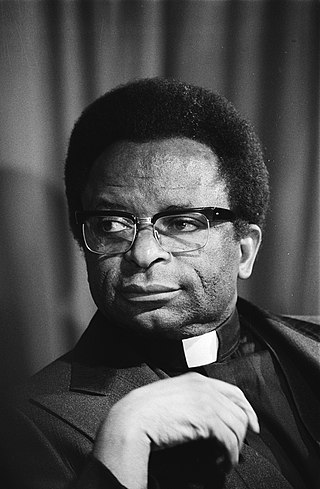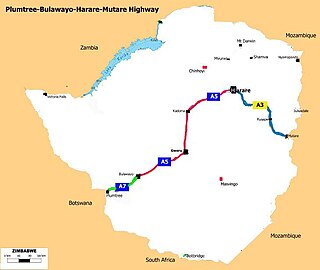
The Zimbabwe African National Union – Patriotic Front (ZANU–PF) is a political organisation which has been the ruling party of Zimbabwe since independence in 1980. The party was led for many years by Robert Mugabe, first as prime minister with the Zimbabwe African National Union (ZANU) and then as president from 1987 after the merger with the Zimbabwe African People's Union (ZAPU) and retaining the name ZANU–PF, until 2017, when he was removed as leader.

The Zimbabwe African National Union (ZANU) was a militant socialist organisation that fought against white-minority rule in Rhodesia, formed as a split from the Zimbabwe African People's Union (ZAPU) in 1963. ZANU split in 1975 into wings loyal to Robert Mugabe and Ndabaningi Sithole, later respectively called ZANU–PF and ZANU–Ndonga. These two sub-divisions ran separately at the 1980 general election, where ZANU–PF has been in power ever since, and ZANU–Ndonga a minor opposition party.

Abel Tendekayi Muzorewa, also commonly referred to as Bishop Muzorewa, was a Zimbabwean bishop and politician who served as the first and only Prime Minister of Zimbabwe Rhodesia from the Internal Settlement to the Lancaster House Agreement in 1979. A United Methodist Church bishop and nationalist leader, he held office for only a few months.

The Zimbabwe Broadcasting Corporation (ZBC) is the state-owned broadcaster in Zimbabwe. It was established as the Rhodesian Broadcasting Corporation (RBC), taking its current name in 1980. Like the RBC before it, the ZBC has been accused of being a government mouthpiece with no editorial independence.

The National Railways of Zimbabwe (NRZ), formerly Rhodesia Railways (RR), is a Bulawayo headquartered state-owned enterprise that operates the country's national railway system. It was established in 1893 and governed by an Act of Parliament. It has a commercial-administrative center in Harare and a supply center in Gweru. The Zimbabwean railway system was largely constructed during the 20th century.

The Zimbabwe National Army (ZNA) is the primary branch of the Zimbabwe Defence Forces responsible for land-oriented military operations. It is the largest service branch under the Zimbabwean Joint Operations Command (JOC). The modern army has its roots in the Rhodesian Army, which was raised between 1963 and 1964 after the breakup of the Federation of Rhodesia and Nyasaland. A Joint High Command created in March 1980 to oversee integration of the formerly belligerent Rhodesian Security Forces, Zimbabwe African National Liberation Army (ZANLA), and the Zimbabwe People's Revolutionary Army (ZIPRA) officially established the Zimbabwe National Army in late 1980, nearly a year after the end of the Rhodesian Bush War.

Zimbabwe Premier Soccer League is the top professional division of the Zimbabwe Football Association. It was founded in 1980, as a successor to the 1962 formed Rhodesia National Football League. It is currently sponsored by Delta Beverages under the Castle Lager brand and hence is known as Castle Lager Premier Soccer League. The current sponsorship deal runs from 2011 and is worth $3.6 million.
Articles related to Zimbabwe include:

The Herald is a state-owned daily newspaper published in Harare, the capital of Zimbabwe.
The media of Zimbabwe has varying amounts of control by successive governments, coming under tight restriction in recent years by the government of Robert Mugabe, particularly during the growing economic and political crisis in the country. The Zimbabwean constitution promotes freedom of the media and expression, however this is hampered by interference and the implementation of strict media laws. In its 2008 report, Reporters Without Borders ranked the Zimbabwean media as 151st out of 173.

The Chronicle is a popular daily newspaper in Zimbabwe. It is published in Bulawayo and mostly reports on news in the Matebeleland region in the southern part of the country. It is state-owned and therefore usually only publishes news that supports the government and its policies. It also covers stories on national and international news, as well as entertainment, sport, business, travel, job offers and real estate. It was established in 1894 and it was the largest newspaper in the country following The Herald.

The Plumtree-Bulawayo-Harare-Mutare Highway is a cross country international standard highway in Zimbabwe. It connects Mutare with Plumtree via Harare and Bulawayo. It is formed by two routes, namely the R5 Road and the R2 Road.
Star FM is a commercial urban radio station that broadcasts throughout Zimbabwe from the country's capital, Harare.

Beira-Bulawayo railway, also called Machipanda railway, Beira-Harare-Bulawayo railway and Beira railway, is a railway that connects the city of Beira, Mozambique, to the city of Bulawayo, in Zimbabwe. It is 850 km long, in a 1067 mm gauge.
Lazarus Nkala, known in political circles by the nickname UMavava, was a Rhodesian trade union leader, activist, and revolutionary. Born in Filabusi in Matabeleland, he attended mission and government schools and trained as a builder. He worked in Bulawayo, and became a union leader and African nationalist activist. In the 1950s and 60s, he served in leadership roles in the Southern Rhodesia African National Congress, National Democratic Party, and Zimbabwe African People's Union. He was detained in 1964 and, with the exception of a three-week period the following year, was held in continuous detention for the next ten years. Upon his release in 1974, he was named Organising Secretary of the ANC, and attended the Victoria Falls Conference as part of Joshua Nkomo's delegation. He died shortly after in an automobile accident driving from Salisbury to Bulawayo.
Allan Norman "Rusty" Markham is a Zimbabwean farmer and politician who was elected to the National Assembly of Zimbabwe for Harare North in the 2018 general election as a member of the MDC Alliance. He crossed the floor to the newly formed Citizens Coalition for Change and was elected Member of Parliament for the neighbouring Harare East constituency in the 2023 general election.
Christopher Peter Mutekwatekwa Chingosho is a Zimbabwean politician who is currently a member of the National Assembly of Zimbabwe for Headlands since 2015. He also served as deputy minister of local government and housing from 2017 to 2018. Previously, he worked in several government ministries and as a district and provincial administrator. He is a member of ZANU–PF, having joined the party in Mozambique during the Rhodesian Bush War in 1975.
Michael Theodore Hayes Auret was a Zimbabwean farmer, politician, and activist. A devout Catholic, he served as chairman and later director of the Catholic Commission for Justice and Peace in Zimbabwe (CCJP) from 1978 until 1999. He also served as a member of Parliament for Harare Central from 2000 to 2003, when he resigned and emigrated to Ireland.

Callistus Dingiswayo Ndlovu was a Zimbabwean academic, diplomat, and politician. He joined the Zimbabwe African People's Union (ZAPU) in 1963 as a teacher in Matabeleland, and went on to serve as its representative to the United Nations and North America in the 1970s. After Zimbabwe's independence in 1980, he was a member of the House of Assembly from 1980 to 1985 and served as a senator from 1985 to 1990. He left ZAPU and joined the ruling ZANU–PF party in 1984.











